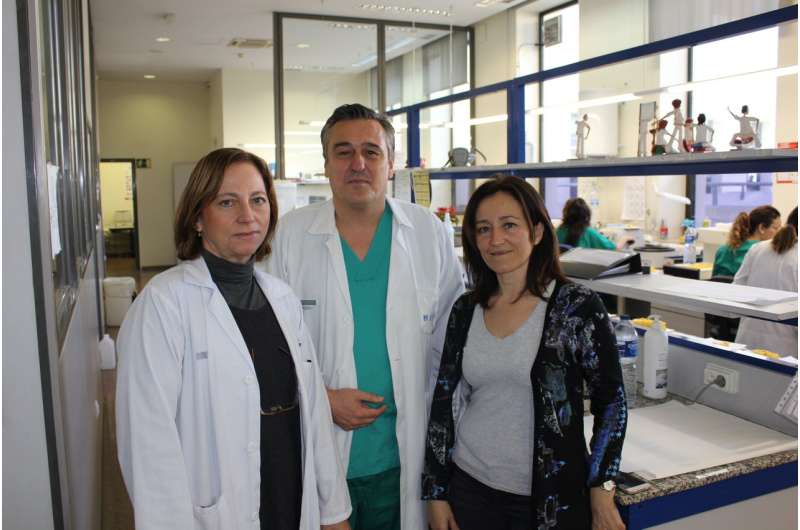Credit: Asociación RUVID
Researchers of the Universitat Politècnica de València and the Universidad de Granada, together with doctors from the Hospital Clínic Universitari de València, are working on the development of a new system to diagnose prostate cancer.
Researchers have already developed an online application that helps pathologists evaluate samples obtained in biopsies, as well as an initial version of the system that is capable of establishing whether the samples are carcinogenic or not.
The website is a tool of great use for an initial evaluation of patient histopathological samples, allowing pathologists to analyze an image of each sample. "After loading the high resolution images onto the system, they can be magnified without losing resolution, which makes for an improved analysis of each sample. Pathologists can draw on the image, marking the affected areas and indicating the Gleason grading system level observed in each area. This written data is what will then be taken into account by our system," explains Valery Naranjo, coordinator of the Computer Vision and Behaviour Analysis Lab-I3B of the Universitat Politècnica de València.
Meanwhile, on the first version of the system, Naranjo outlines the fact that it can extract new features from which to tell carcinogenic cells from healthy ones with 95 percent sensitivity and 99 percent specificity. Work is now centred on training the system to detect carcinogenic samples and indicate the cancer stage.
Prostate cancer and its detection
Prostate cancer is the most common cause of death among men over 70, and the average age of diagnosis is 66. A majority of cases—92 percent—are detected at a late stage when the illness is located in the prostate gland or neighbouring organs.
The procedure to obtain the diagnosis starts with a visit to the urologist, with a clinical interview, physical exploration, and, if relevant, a request for a blood test to check for the presence of prostate-specific antigen (PSA).
"This technique has increased the ability to detect this illness among population at risk. However, the determining test for its diagnosis is a prostate biopsy, as PSA is unspecific and leads to a large amount of false positives," Valery Naranjo adds.
A faster and more precise and objective diagnosis
According to María Angeles Sales Maicas from the Hospital Clínic Universitari de València's Department of Pathologic Anatomy, all biopsy samples obtained by the urologist are processed in the lab for a subsequent analysis and evaluation by the pathologist by means of optical microscopy. "It is the pathologist who determines whether there is cancer or not, and if there is, he determines the stage of the cancer thanks to the Gleason scale, which is used to establish a prognosis. This scale has five levels and its use is subjective, which makes its reproducibility harder, especially in stages three and four," adds Dr. Sales.
The system created as part of the SICAP project will make it possible to automatically segment images of the histopathological samples obtained in prostate biopsies, as well as to extract features based on the tissue's structure. "It would be the extraction of these features which would help pathologists diagnose and evaluate tumours, as well as to classify them more objectively, specially in stages three and four," adds Dr. Francisco García Morata, from the Urology Department at the Hospital Clínic Universitari de València.
Therefore, the SICAP system will not substitute the pathologist, but instead get rid of a majority of the subjectivity that comes with the analysis of this type of samples, giving the urologist more robust information to determine the tumour's aggressiveness as well as the patient's prognosis. This will in turn allow us to establish therapeutic options that are more appropriate for each type of tumour. "It can be specially useful in smaller hospitals, where a reduced number of pathologists prevents their sub-specialisation, which decreases the precision when it comes to making a subjective analysis of biopsy samples," says Dr. José Mª Martínez Jabaloyas, from the Urology Department at the Hospital Clínic Universitari de València.
Furthermore, the system adds a series of self-learning algorithms, so that it will automatically compare the features of recent samples with those registered previously, making diagnosis easier and faster.
Rafael Molina, researcher for the Department of Computer Sciences and Artificial Intelligence at the Universidad de Granada, explains that this system, which is currently based on extracting morphological features from histological images in order to then classify them using Gaussian processes, will soon add the unsupervised collection of hematoxylin and eosin stains as well as the automatic mining of relevant features from said images by using Deep Learning techniques.
Provided by Asociacion RUVID






















